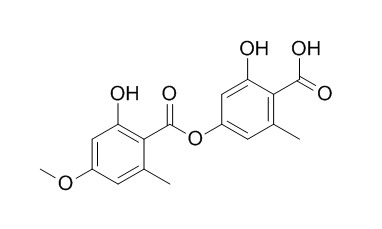Evernic acid
Usnic acid exerts the Nrf2 cytoprotective activity. Usnic acid and evernic acid merit further research as promising antioxidant candidates in the therapy of oxidative stress-related diseases, including the neurodegenerative disorders.
Inquire / Order:
manager@chemfaces.com
Technical Inquiries:
service@chemfaces.com
Tel:
+86-27-84237783
Fax:
+86-27-84254680
Address:
1 Building, No. 83, CheCheng Rd., Wuhan Economic and Technological Development Zone, Wuhan, Hubei 430056, PRC
Providing storage is as stated on the product vial and the vial is kept tightly sealed, the product can be stored for up to
24 months(2-8C).
Wherever possible, you should prepare and use solutions on the same day. However, if you need to make up stock solutions in advance, we recommend that you store the solution as aliquots in tightly sealed vials at -20C. Generally, these will be useable for up to two weeks. Before use, and prior to opening the vial we recommend that you allow your product to equilibrate to room temperature for at least 1 hour.
Need more advice on solubility, usage and handling? Please email to: service@chemfaces.com
The packaging of the product may have turned upside down during transportation, resulting in the natural compounds adhering to the neck or cap of the vial. take the vial out of its packaging and gently shake to let the compounds fall to the bottom of the vial. for liquid products, centrifuge at 200-500 RPM to gather the liquid at the bottom of the vial. try to avoid loss or contamination during handling.
Nutrients.2022, 14(16):3393.
J Holistic Integrative Pharm.2023, 4(1):14-28
Sci Rep.2021, 11(1):21038.
Korean Journal of Pharmacognosy2014, 113-120
Biochem Pharmacol. 2023, 210:115463.
Phytomedicine.2024, 122:155065.
Rev. Chim.2020, 71(3),558-564
Turkish Journal of Pharmaceutical Sciences2022, DOI: 10.4274
Int J Mol Sci.2023, 24(14):11496.
Drug Chem Toxicol.2020, 1-14.
Related and Featured Products
Natural Product Communications, 2014, 9(4):503-504.
Clastogenic effect of atranorin, evernic acid, and usnic acid on human lymphocytes.[Reference:
WebLink]
METHODS AND RESULTS:
Three lichen secondary metabolites atranorin (1), Evernic acid (2), and usnic acid (3), were evaluated for their in vitro clastogenic and antiproliferative effects on human lymphocytes using the cytochalasin-B blocked micronucleus (CBMN) assay at concentrations of 2 microg/mL, 4 microg/mL and 6 microg/mL of final culture solution. The frequency of micronucleus (MN) was scored in binucleated cells, and cytokinesis-block proliferation index (CBPI) was calculated. Among the tested compounds, 3 exhibited the most prominent effect decreasing the frequency of MN in the range of 42.5% - 48.9%, that is about double of the positive control amifostin WR-2721 that reduces MN frequency for 22.0%. The effect of Evernic acid was approximately equal to action of amifostin (23.2% -32.9%). Atranorin at concentrations of 2 microg/mL and 4 microg/mL decreasing the frequency of MN only for 11.1% and 1.8%, while in concentration of 6 microg/mL increases the frequency of MN for 9.6 %.
CONCLUSIONS:
The comparable CBPI values of the investigated compounds and control suggested that they did not show a statistically significant inhibitory effect on lymphocyte cell proliferation at applied concentrations.
Planta Medica, 2009, 75(06):607-613.
Antiproliferative effects on tumour cells and promotion of keratinocyte wound healing by different lichen compounds.[Reference:
WebLink]
Five compounds representative of major structural classes of lichen polyketides, VIZ. (+)-usnic (1), salazinic (2), vulpinic (3), gyrophoric (4), and Evernic acids (5), were investigated for their ability to affect cell proliferation or wound healing, two functional targets of relevance for research on cancer or tissue regeneration.
METHODS AND RESULTS:
The experiments were carried out on MM98 malignant mesothelioma cells, A431 vulvar carcinoma cells, and HaCaT keratinocytes. The NRU and CV cytotoxicity assays showed high toxicity for (+)-usnic acid, intermediate toxicity for vulpinic acid, and low toxicity for salazinic, gyrophoric and Evernic acids. Scratch wounding experiments on HaCaT monolayers, in the presence of subtoxic doses of lichen compounds, showed strong wound closure effects by (+)-usnic and gyrophoric acid, an intermediate effect by vulpinic and salazinic acids, and no effect by Evernic acid. A combination of (+)-usnic and gyrophoric acids gave a further increase in the wound closure rates.
The results of a cell migration test correlated with the wound healing data.
CONCLUSIONS:
In conclusion, (+)-usnic acid might be a particularly interesting compound for the prevention of hyperproliferation syndromes, while (+)-usnic and gyrophoric acids qualify as interesting leads in the promotion of tissue regeneration.
Food & Chemical Toxicology, 2017, 105:262-277.
Protective effects of lichen metabolites evernic and usnic acids against redox impairment-mediated cytotoxicity in central nervous system-like cells.[Reference:
WebLink]
Lichens species produce unique secondary metabolites that attract increasing pharmacological interest, including their redox modulatory activities. Current work evaluated for the first time the in vitro cytoprotective properties, based on the antioxidant activities, of the Parmeliaceae lichens Evernia prunastri and Usnea ghattensis and the mechanism of action of their major phenolic constituents: the Evernic acid and usnic acid, respectively.
METHODS AND RESULTS:
In two models of central nervous system-like cells (U373-MG and SH-SY5Y cell lines), exogenous H2O2 induced oxidative stress-mediated cytotoxicity. We first assessed their radical scavenging capacities (ORAC and DPPH tests) and the phenolic content of the extracts. At the optimal concentrations, pretreatments with Evernic acid displayed significant protection against H2O2-induced cytotoxic damage in both models. It reversed the alterations in oxidative stress markers (including ROS generation, glutathione system and lipid peroxidation levels) and cellular apoptosis (caspase-3 activity). Such effects were in part mediated by a notable enhancement of the expression of intracellular phase-II antioxidant enzymes; a plausible involvement of the Nrf2 cytoprotective pathway is suggested. Usnic acid exerted similar effects, to some extent more moderate.
CONCLUSIONS:
Results suggest that lichen polyketides Evernic acid and usnic acid merit further research as promising antioxidant candidates in the therapy of oxidative stress-related diseases, including the neurodegenerative disorders.



